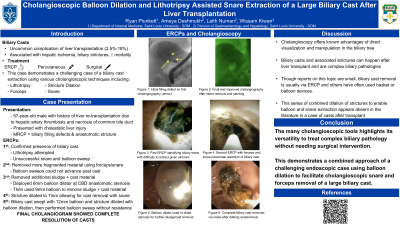Sunday Poster Session
Category: Endoscopy Video Forum
P0463 - Cholangioscopic Balloon Dilation and Lithotripsy-Assisted Snare Extraction of a Large Biliary Cast After Liver Transplantation
Sunday, October 27, 2024
3:30 PM - 7:00 PM ET
Location: Exhibit Hall E

Has Audio

Ryan Plunkett, MD
Saint Louis University School of Medicine
St. Louis, MO
Presenting Author(s)
Ryan Plunkett, MD1, Ameya Deshmukh, DO1, Laith Numan, MD, MS2, Wissam Kiwan, MD3
1Saint Louis University School of Medicine, St. Louis, MO; 2SSM Health Saint Louis University Hospital, St. Louis, MO; 3Saint Louis University, St. Louis, MO
Introduction: Biliary casts are an uncommon complication following liver transplantation, reported at rates between 2.5%-18%. They are notably associated with hepatic ischemia, biliary strictures, and increased mortality. Treatment includes endoscopic retrograde cholangiopancreatography (ERCP), or percutaneous and surgical approaches. Here, we demonstrate a challenging case of a biliary cast extraction using various cholangioscopic techniques including lithotripsy, stricture dilation, forceps, and snare.
Case Description/Methods: A 57-year-old man with a history of liver re-transplantation due to hepatic artery thrombosis and necrosis of the donor common bile duct, after receiving an orthotopic liver transplant due to alcohol-related cirrhosis, presented with a cholestatic liver injury prompting magnetic resonance cholangiopancreatography. Imaging showed biliary filling defects and a likely anastomotic stricture and the patient underwent a series of diagnostic and therapeutic ERCPs. The first ERCP confirmed the presence of a biliary cast. Lithotripsy was attempted and the cast was disrupted using forceps for piecemeal extraction. Further extraction was unsuccessfully attempted with a snare and cholangiogram balloon sweep. The second ERCP was able to remove more fragmented material with forceps and the snare. Filling defects improved on the cholangiogram, however balloon sweeps could not advance past the cast. The third ERCP removed additional sludge and cast material with a 9 mm balloon. A 6 mm balloon dilator was also successfully deployed over a common bile duct anastomotic stenosis. In the fourth ERCP, the stricture was dilated to 7 mm, allowing for complete cast removal with a snare.
Discussion: This case highlights known advantages of cholangioscopy, such as direct visualization of the cast, as well as the therapeutic potential of the cholangioscopic accessories such as the demonstrated combined approach utilizing lithotripsy, stricture dilation, and snare retrieval to achieve complete cast removal. Furthermore, it adds to the growing trend of endoscopy’s shift towards therapeutics as this case likely would have required a surgical referral in the past due to the cast size and anatomical complexity.
Disclosures:
Ryan Plunkett, MD1, Ameya Deshmukh, DO1, Laith Numan, MD, MS2, Wissam Kiwan, MD3. P0463 - Cholangioscopic Balloon Dilation and Lithotripsy-Assisted Snare Extraction of a Large Biliary Cast After Liver Transplantation, ACG 2024 Annual Scientific Meeting Abstracts. Philadelphia, PA: American College of Gastroenterology.
1Saint Louis University School of Medicine, St. Louis, MO; 2SSM Health Saint Louis University Hospital, St. Louis, MO; 3Saint Louis University, St. Louis, MO
Introduction: Biliary casts are an uncommon complication following liver transplantation, reported at rates between 2.5%-18%. They are notably associated with hepatic ischemia, biliary strictures, and increased mortality. Treatment includes endoscopic retrograde cholangiopancreatography (ERCP), or percutaneous and surgical approaches. Here, we demonstrate a challenging case of a biliary cast extraction using various cholangioscopic techniques including lithotripsy, stricture dilation, forceps, and snare.
Case Description/Methods: A 57-year-old man with a history of liver re-transplantation due to hepatic artery thrombosis and necrosis of the donor common bile duct, after receiving an orthotopic liver transplant due to alcohol-related cirrhosis, presented with a cholestatic liver injury prompting magnetic resonance cholangiopancreatography. Imaging showed biliary filling defects and a likely anastomotic stricture and the patient underwent a series of diagnostic and therapeutic ERCPs. The first ERCP confirmed the presence of a biliary cast. Lithotripsy was attempted and the cast was disrupted using forceps for piecemeal extraction. Further extraction was unsuccessfully attempted with a snare and cholangiogram balloon sweep. The second ERCP was able to remove more fragmented material with forceps and the snare. Filling defects improved on the cholangiogram, however balloon sweeps could not advance past the cast. The third ERCP removed additional sludge and cast material with a 9 mm balloon. A 6 mm balloon dilator was also successfully deployed over a common bile duct anastomotic stenosis. In the fourth ERCP, the stricture was dilated to 7 mm, allowing for complete cast removal with a snare.
Discussion: This case highlights known advantages of cholangioscopy, such as direct visualization of the cast, as well as the therapeutic potential of the cholangioscopic accessories such as the demonstrated combined approach utilizing lithotripsy, stricture dilation, and snare retrieval to achieve complete cast removal. Furthermore, it adds to the growing trend of endoscopy’s shift towards therapeutics as this case likely would have required a surgical referral in the past due to the cast size and anatomical complexity.
Disclosures:
Ryan Plunkett indicated no relevant financial relationships.
Ameya Deshmukh indicated no relevant financial relationships.
Laith Numan indicated no relevant financial relationships.
Wissam Kiwan indicated no relevant financial relationships.
Ryan Plunkett, MD1, Ameya Deshmukh, DO1, Laith Numan, MD, MS2, Wissam Kiwan, MD3. P0463 - Cholangioscopic Balloon Dilation and Lithotripsy-Assisted Snare Extraction of a Large Biliary Cast After Liver Transplantation, ACG 2024 Annual Scientific Meeting Abstracts. Philadelphia, PA: American College of Gastroenterology.
